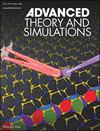高性能无铅钙钛矿太阳能电池的能级对准和缺陷钝化综合增强
IF 2.9
4区 工程技术
Q1 MULTIDISCIPLINARY SCIENCES
引用次数: 0
摘要
基于CsGeI2Br的钙钛矿具有良好的带隙和高的吸收系数,作为高效的无铅钙钛矿太阳能电池(PSCs)的候选材料具有很大的前景。然而,钙钛矿-输运层界面处明显的缺陷复合和能量排列错配限制了器件的性能和长期稳定性。为了克服这些挑战,通过严格的数值模拟优化光学和电子参数,包括传输层材料、掺杂密度、体/界面缺陷密度和载流子迁移率,解锁了器件的光伏潜力。结果,优化后的器件实现了28.00%的冠军功率转换效率。为了进一步阐明其固有的物理行为,我们还研究了载流子复合的激活能,以及电导率和价带偏移。此外,还简要介绍了不同类型的器件结构,包括p - i - n和无html结构。最后,提出了提高器件效率的详细路线图,为改进无机无铅CsGeI2Br钙钛矿太阳能电池在光电应用中的应用提供了有价值的见解。本文章由计算机程序翻译,如有差异,请以英文原文为准。
Integrative Enhancement of Energy‐Level Alignment and Defect Passivation for High‐Performance Lead‐Free Perovskite Solar Cells
CsGeI2 Br‐based perovskites with a favorable bandgap and high absorption coefficient, show great promise as candidates for efficient lead‐free perovskite solar cells (PSCs). However, the significant defect recombination and energy alignment mismatch at the perovskite‐transport layer interface limit both the device's performance and long‐term stability. To overcome these challenges, the photovoltaic potential of the device is unlocked by optimizing the optical and electronic parameters through a rigorous numerical simulation, including the transport layer materials, doping density, bulk/interface defect density, and carrier mobility. As a result, the optimized device achieved a champion power conversion efficiency of 28.00%. To further elucidate the inherent physical behavior, the activator energy of carrier recombination, along with the conduction and valence band offsets, are also investigated. Additionally, different types of device structures, including p‐i‐n and HTL‐free structures, are briefly examined. Finally, a detailed roadmap for enhancing the efficiency of the device is proposed, offering valuable insights for improving inorganic lead‐free CsGeI2 Br perovskite solar cells in optoelectronic applications.
求助全文
通过发布文献求助,成功后即可免费获取论文全文。
去求助
来源期刊

Advanced Theory and Simulations
Multidisciplinary-Multidisciplinary
CiteScore
5.50
自引率
3.00%
发文量
221
期刊介绍:
Advanced Theory and Simulations is an interdisciplinary, international, English-language journal that publishes high-quality scientific results focusing on the development and application of theoretical methods, modeling and simulation approaches in all natural science and medicine areas, including:
materials, chemistry, condensed matter physics
engineering, energy
life science, biology, medicine
atmospheric/environmental science, climate science
planetary science, astronomy, cosmology
method development, numerical methods, statistics
 求助内容:
求助内容: 应助结果提醒方式:
应助结果提醒方式:


